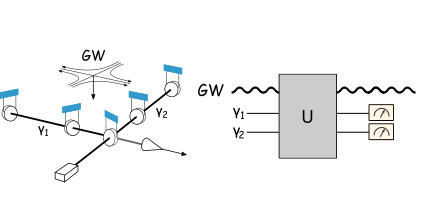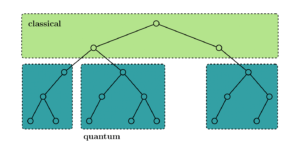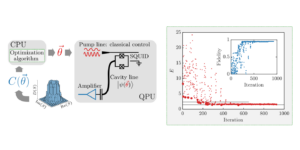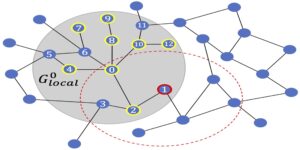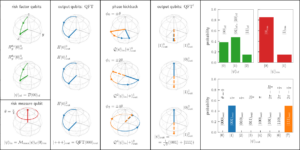1Department of Physics, Pontifical Catholic University of Rio de Janeiro, Rio de Janeiro 22451-900, Brazil
2Istituto del Consiglio Nazionale delle Ricerche, OVI, Italy
3Departament de Física Quàntica i Astrofísica, Institut de Ciències del Cosmos, Universitat de Barcelona, Martí i Franquès 1, E-08028 Barcelona, Spain
4Lawrence Berkeley National Laboratory, Berkeley, CA 94720, USA
5Dipartimento di Matematica e Fisica “E. De Giorgi”, Università del Salento, and Istituto Nazionale di Fisica Nucleare (INFN) sezione di Lecce, via per Arnesano, 73100 Lecce, Italy
Find this paper interesting or want to discuss? Scite or leave a comment on SciRate.
Abstract
The effective quantum field theory description of gravity, despite its non-renormalizability, allows for predictions beyond classical general relativity. As we enter the age of gravitational wave astronomy, an important and timely question is whether measurable quantum predictions that depart from classical gravity, analogous to quantum optics effects which cannot be explained by classical electrodynamics, can be found. In this work, we investigate quantum signatures in gravitational waves using tools from quantum optics. Squeezed-coherent gravitational waves, which can exhibit sub-Poissonian graviton statistics, can enhance or suppress the signal measured by an interferometer, a characteristic effect of quantum squeezing. Moreover, we show that Gaussian gravitational wave quantum states can be reconstructed from measurements over an ensemble of optical fields interacting with a single copy of the gravitational wave, thus opening the possibility of detecting quantum features of gravity beyond classical general relativity.
Featured image: Quantum detection for quantum states of gravitational waves.
Popular summary
Thinking by analogy, however, detecting photons is not the only way of proving the quantum mechanical nature of electromagnetism. Quantum optics has taught us that quantum field fluctuations are measurable in macroscopic states of light – e.g. squeezed and squeezed-coherent states – through linear classical detection such as homodyne and heterodyne measurements. This idea has led us to a search for macroscopic quantum effects of gravitational waves measurable regardless of our ability to detect gravitons. In summary, we ask the question: which predictions of the effective quantum description of gravity departing from classical general relativity could be detected in gravitational wave detectors?
In the present work, we report some of our latest results in the attempt to answer such question. We show that within the low energy effective field theory description of gravity, there exists quantum states of gravitational waves – notably squeezed-coherent states – which could cause non-classical effects measurable using present-day or near-future interferometric detectors such as LIGO and VIRGO. The generation of such quantum states of gravitational waves remains unknown and much still has to be researched, but our work paves the way for a phenomenological search for such effects, which given the non-linear nature of Einstein gravity could be produced in strong field astrophysical events. If detected, the effects we describe provide a smoking gun for the quantum mechanical nature of gravity, thus opening the way to experimental measurements of quantum spacetime.
► BibTeX data
► References
[1] Alexander H Nitz, Collin D Capano, Sumit Kumar, Yi-Fan Wang, Shilpa Kastha, Marlin Schäfer, Rahul Dhurkunde, and Miriam Cabero. “3-ogc: Catalog of gravitational waves from compact-binary mergers”. The Astrophysical Journal 922, 76 (2021).
https://doi.org/10.3847/1538-4357/ac1c03
[2] Belinda Pang and Yanbei Chen. “Quantum interactions between a laser interferometer and gravitational waves”. Phys. Rev. D 98, 124006 (2018).
https://doi.org/10.1103/PhysRevD.98.124006
[3] Thiago Guerreiro. “Quantum effects in gravity waves”. Classical and Quantum Gravity 37, 155001 (2020).
https://doi.org/10.1088/1361-6382/ab9d5d
[4] Luiz Davidovich. “Sub-poissonian processes in quantum optics”. Rev. Mod. Phys. 68, 127–173 (1996).
https://doi.org/10.1103/RevModPhys.68.127
[5] Freeman Dyson. “Is a graviton detectable?”. Int. J. Mod. Phys. A 28, 1330041 (2013).
https://doi.org/10.1142/S0217751X1330041X
[6] A. I. Lvovsky. “Squeezed light”. Chapter 5, pages 121–163. John Wiley & Sons, Ltd. (2015).
https://doi.org/10.48550/arXiv.1401.4118
[7] Francesco Coradeschi, Antonia Micol Frassino, Thiago Guerreiro, Jennifer Rittenhouse West, and Enrico Junior Schioppa. “Can we detect the quantum nature of weak gravitational fields?”. Universe 7 (2021).
https://doi.org/10.3390/universe7110414
[8] Maulik Parikh, Frank Wilczek, and George Zahariade. “Quantum mechanics of gravitational waves”. Phys. Rev. Lett. 127, 081602 (2021).
https://doi.org/10.1103/PhysRevLett.127.081602
[9] Samarth Chawla and Maulik Parikh. “Quantum Gravity Corrections to the Fall of the Apple” (2021). arXiv:2112.14730.
arXiv:2112.14730
[10] Maulik Parikh, Frank Wilczek, and George Zahariade. “Signatures of the quantization of gravity at gravitational wave detectors”. Phys. Rev. D 104, 046021 (2021).
https://doi.org/10.1103/PhysRevD.104.046021
[11] L. P. Grishchuk and Y. V. Sidorov. “Squeezed quantum states of relic gravitons and primordial density fluctuations”. Phys. Rev. D 42, 3413–3421 (1990).
https://doi.org/10.1103/PhysRevD.42.3413
[12] Andreas Albrecht, Pedro Ferreira, Michael Joyce, and Tomislav Prokopec. “Inflation and squeezed quantum states”. Phys. Rev. D 50, 4807–4820 (1994).
https://doi.org/10.1103/PhysRevD.50.4807
[13] Don Koks, Andrew Matacz, and B. L. Hu. “Entropy and uncertainty of squeezed quantum open systems”. Phys. Rev. D 55, 5917–5935 (1997).
https://doi.org/10.1103/PhysRevD.55.5917
[14] S. Hawking. “Black hole explosions?”. Nature 248, 30–31 (1974).
https://doi.org/10.1038/248030a0
[15] Mark P. Hertzberg and Jacob A. Litterer. “Bound on Quantum Fluctuations in Gravitational Waves from LIGO” (2021). arXiv:2112.12159.
arXiv:2112.12159
[16] W. Schleich and J. A. Wheeler. “Oscillations in photon distribution of squeezed states”. J. Opt. Soc. Am. B 4, 1715–1722 (1987).
https://doi.org/10.1364/JOSAB.4.001715
[17] Charles W. Misner, K. S. Thorne, and J. A. Wheeler. “Gravitation”. W. H. Freeman. San Francisco (1973).
[18] M. S. Safronova, D. Budker, D. DeMille, Derek F. Jackson Kimball, A. Derevianko, and Charles W. Clark. “Search for new physics with atoms and molecules”. Rev. Mod. Phys. 90, 025008 (2018).
https://doi.org/10.1103/RevModPhys.90.025008
[19] Fernando Monteiro, Gadi Afek, Daniel Carney, Gordan Krnjaic, Jiaxiang Wang, and David C. Moore. “Search for composite dark matter with optically levitated sensors”. Phys. Rev. Lett. 125, 181102 (2020).
https://doi.org/10.1103/PhysRevLett.125.181102
[20] Charles P. Blakemore, Alexander Fieguth, Akio Kawasaki, Nadav Priel, Denzal Martin, Alexander D. Rider, Qidong Wang, and Giorgio Gratta. “Search for non-newtonian interactions at micrometer scale with a levitated test mass”. Phys. Rev. D 104, L061101 (2021).
https://doi.org/10.1103/PhysRevD.104.L061101
[21] David C Moore and Andrew A Geraci. “Searching for new physics using optically levitated sensors”. Quantum Science and Technology 6, 014008 (2021).
https://doi.org/10.1088/2058-9565/abcf8a
[22] K. M. Backes et al. “A quantum enhanced search for dark matter axions”. NaturePage 238 (2021).
https://doi.org/10.1038/s41586-021-03226-7
[23] Deniz Aybas, Janos Adam, Emmy Blumenthal, Alexander V. Gramolin, Dorian Johnson, Annalies Kleyheeg, Samer Afach, John W. Blanchard, Gary P. Centers, Antoine Garcon, Martin Engler, Nataniel L. Figueroa, Marina Gil Sendra, Arne Wickenbrock, Matthew Lawson, Tao Wang, Teng Wu, Haosu Luo, Hamdi Mani, Philip Mauskopf, Peter W. Graham, Surjeet Rajendran, Derek F. Jackson Kimball, Dmitry Budker, and Alexander O. Sushkov. “Search for axionlike dark matter using solid-state nuclear magnetic resonance”. Phys. Rev. Lett. 126, 141802 (2021).
https://doi.org/10.1103/PhysRevLett.126.141802
[24] Peter W. Graham, David E. Kaplan, Jeremy Mardon, Surjeet Rajendran, William A. Terrano, Lutz Trahms, and Thomas Wilkason. “Spin precession experiments for light axionic dark matter”. Phys. Rev. D 97, 055006 (2018).
https://doi.org/10.1103/PhysRevD.97.055006
[25] K. Wurtz, B.M. Brubaker, Y. Jiang, E.P. Ruddy, D.A. Palken, and K.W. Lehnert. “Cavity entanglement and state swapping to accelerate the search for axion dark matter”. PRX Quantum 2, 040350 (2021).
https://doi.org/10.1103/PRXQuantum.2.040350
[26] J. Estrada, R. Harnik, D. Rodrigues, and M. Senger. “Searching for dark particles with quantum optics”. PRX Quantum 2, 030340 (2021).
https://doi.org/10.1103/PRXQuantum.2.030340
[27] D Carney, G Krnjaic, D C Moore, C A Regal, G Afek, S Bhave, B Brubaker, T Corbitt, J Cripe, N Crisosto, A Geraci, S Ghosh, J G E Harris, A Hook, E W Kolb, J Kunjummen, R F Lang, T Li, T Lin, Z Liu, J Lykken, L Magrini, J Manley, N Matsumoto, A Monte, F Monteiro, T Purdy, C J Riedel, R Singh, S Singh, K Sinha, J M Taylor, J Qin, D J Wilson, and Y Zhao. “Mechanical quantum sensing in the search for dark matter”. Quantum Science and Technology 6, 024002 (2021).
https://doi.org/10.1088/2058-9565/abcfcd
[28] Tanjung Krisnanda, Margherita Zuppardo, Mauro Paternostro, and Tomasz Paterek. “Revealing nonclassicality of inaccessible objects”. Phys. Rev. Lett. 119, 120402 (2017).
https://doi.org/10.1103/PhysRevLett.119.120402
[29] Sougato Bose, Anupam Mazumdar, Gavin W. Morley, Hendrik Ulbricht, Marko Toroš, Mauro Paternostro, Andrew A. Geraci, Peter F. Barker, M. S. Kim, and Gerard Milburn. “Spin entanglement witness for quantum gravity”. Phys. Rev. Lett. 119, 240401 (2017).
https://doi.org/10.1103/PhysRevLett.119.240401
[30] C. Marletto and V. Vedral. “Gravitationally induced entanglement between two massive particles is sufficient evidence of quantum effects in gravity”. Phys. Rev. Lett. 119, 240402 (2017).
https://doi.org/10.1103/PhysRevLett.119.240402
[31] Teodora Oniga and Charles H.-T. Wang. “Quantum gravitational decoherence of light and matter”. Phys. Rev. D 93, 044027 (2016).
https://doi.org/10.1103/PhysRevD.93.044027
[32] Daniel Carney, Holger Müller, and Jacob M. Taylor. “Using an atom interferometer to infer gravitational entanglement generation”. PRX Quantum 2, 030330 (2021).
https://doi.org/10.1103/PRXQuantum.2.030330
[33] Daniel Carney, Holger Müller, and Jacob M. Taylor. “Comment on using an atom interferometer to infer gravitational entanglement generation” (2021). arXiv:2111.04667.
arXiv:2111.04667
[34] Kirill Streltsov, Julen Simon Pedernales, and Martin Bodo Plenio. “On the Significance of Interferometric Revivals for the Fundamental Description of Gravity”. Universe 8, 58 (2022). arXiv:2111.04570.
https://doi.org/10.3390/universe8020058
arXiv:2111.04570
[35] Tobias Westphal, Hans Hepach, Jeremias Pfaff, and Markus Aspelmeyer. “Measurement of gravitational coupling between millimetre-sized masses”. NaturePage 225 (2021).
https://doi.org/10.1038/s41586-021-03250-7
[36] Markus Aspelmeyer. “When Zeh Meets Feynman: How to Avoid the Appearance of a Classical World in Gravity Experiments”. Fundam. Theor. Phys. 204, 85–95 (2022). arXiv:2203.05587.
https://doi.org/10.1007/978-3-030-88781-0_5
arXiv:2203.05587
[37] Rafal Demkowicz-Dobrzański, Marcin Jarzyna, and Jan Kołodyński. “Chapter four – quantum limits in optical interferometry”. Volume 60 of Progress in Optics, pages 345–435. Elsevier. (2015).
https://doi.org/10.1016/bs.po.2015.02.003
[38] Marko Toroš, Anupam Mazumdar, and Sougato Bose. “Loss of coherence of matter-wave interferometer from fluctuating graviton bath” (2020). arXiv:2008.08609.
arXiv:2008.08609
[39] Alessandra Buonanno and Yanbei Chen. “Scaling law in signal recycled laser-interferometer gravitational-wave detectors”. Phys. Rev. D 67, 062002 (2003).
https://doi.org/10.1103/PhysRevD.67.062002
[40] Marlan O. Scully and M. Suhail Zubairy. “Quantum optics”. Cambridge University Press. (1997).
[41] Igor Brandão, Bruno Suassuna, Bruno Melo, and Thiago Guerreiro. “Entanglement dynamics in dispersive optomechanics: Nonclassicality and revival”. Phys. Rev. Research 2, 043421 (2020).
https://doi.org/10.1103/PhysRevResearch.2.043421
[42] M. P. Blencowe. “Effective field theory approach to gravitationally induced decoherence”. Phys. Rev. Lett. 111, 021302 (2013).
https://doi.org/10.1103/PhysRevLett.111.021302
[43] A. A. Clerk, M. H. Devoret, S. M. Girvin, Florian Marquardt, and R. J. Schoelkopf. “Introduction to quantum noise, measurement, and amplification”. Rev. Mod. Phys. 82, 1155–1208 (2010).
https://doi.org/10.1103/RevModPhys.82.1155
[44] E. Oudot, P. Sekatski, F. Fröwis, N. Gisin, and N. Sangouard. “Two-mode squeezed states as schrödinger cat-like states”. J. Opt. Soc. Am. B 32, 2190–2197 (2015).
https://doi.org/10.1364/JOSAB.32.002190
[45] Wojciech H. Zurek, Salman Habib, and Juan Pablo Paz. “Coherent states via decoherence”. Phys. Rev. Lett. 70, 1187–1190 (1993).
https://doi.org/10.1103/PhysRevLett.70.1187
[46] Charles W Misner, Kip Thorne, and Wojciech Żurek. “John wheeler, relativity, and quantum information”. Physics Today 62 (2009).
https://doi.org/10.1063/1.3120895
[47] DF Walls and GJ Milburn. “Quantum optics (springer, berlin” (1994).
[48] Edward B. Rockower. “Calculating the quantum characteristic function and the photon-number generating function in quantum optics”. Phys. Rev. A 37, 4309–4318 (1988).
https://doi.org/10.1103/PhysRevA.37.4309
[49] Christian Weedbrook, Stefano Pirandola, Raúl García-Patrón, Nicolas J. Cerf, Timothy C. Ralph, Jeffrey H. Shapiro, and Seth Lloyd. “Gaussian quantum information”. Rev. Mod. Phys. 84, 621–669 (2012).
https://doi.org/10.1103/RevModPhys.84.621
[50] V. V. Dodonov, O. V. Man’ko, and V. I. Man’ko. “Multidimensional hermite polynomials and photon distribution for polymode mixed light”. Phys. Rev. A 50, 813–817 (1994).
https://doi.org/10.1103/PhysRevA.50.813
[51] Michael Vanner, Igor Pikovski, and M. Kim. “Towards optomechanical quantum state reconstruction of mechanical motion”. Annalen der Physik 527 (2015).
https://doi.org/10.1002/andp.201400124
[52] Robert W. Boyd. “Nonlinear optics”. Academic Press. (2008).
[53] L. D. Landau and E. M. Lifshitz. “The classical theory of fields course of theoretical physics”. Butterworth-Heinemann. (1975).
[54] Benjamin P. Abbott et al. “The basic physics of the binary black hole merger GW150914”. Annalen Phys. 529, 1600209 (2017). arXiv:1608.01940.
https://doi.org/10.1002/andp.201600209
arXiv:1608.01940
[55] F. Shojaei Arani, M. Bagheri Harouni, B. Lamine, and A. Blanchard. “Imprints of the Squeezed Primordial Gravitational Waves on the Quantum Electromagnetic Field” (2021). arXiv:2110.10962.
arXiv:2110.10962
[56] Bonny L. Schumaker and Carlton M. Caves. “New formalism for two-photon quantum optics. ii. mathematical foundation and compact notation”. Phys. Rev. A 31, 3093–3111 (1985).
https://doi.org/10.1103/PhysRevA.31.3093
[57] Andreas Albrecht, Pedro Ferreira, Michael Joyce, and Tomislav Prokopec. “Inflation and squeezed quantum states”. Phys. Rev. D 50, 4807–4820 (1994). arXiv:astro-ph/9303001.
https://doi.org/10.1103/PhysRevD.50.4807
arXiv:astro-ph/9303001
[58] Sugumi Kanno and Jiro Soda. “Detecting nonclassical primordial gravitational waves with hanbury-brown–twiss interferometry”. Phys. Rev. D 99, 084010 (2019).
https://doi.org/10.1103/PhysRevD.99.084010
[59] Dieter R. Brill and James B. Hartle. “Method of the self-consistent field in general relativity and its application to the gravitational geon”. Phys. Rev. 135, B271–B278 (1964).
https://doi.org/10.1103/PhysRev.135.B271
[60] R. F. Sawyer. “Quantum break in high intensity gravitational wave interactions”. Phys. Rev. Lett. 124, 101301 (2020).
https://doi.org/10.1103/PhysRevLett.124.101301
[61] M. T. Grisaru, P. van Nieuwenhuizen, and C. C. Wu. “Gravitational born amplitudes and kinematical constraints”. Phys. Rev. D 12, 397–403 (1975).
https://doi.org/10.1103/PhysRevD.12.397
[62] Yosef Zlochower, Roberto Gómez, Sascha Husa, Luis Lehner, and Jeffrey Winicour. “Mode coupling in the nonlinear response of black holes”. Phys. Rev. D 68, 084014 (2003).
https://doi.org/10.1103/PhysRevD.68.084014
[63] Aaron Zimmerman and Zachary Mark. “Damped and zero-damped quasinormal modes of charged, nearly extremal black holes”. Phys. Rev. D 93, 044033 (2016).
https://doi.org/10.1103/PhysRevD.93.044033
[64] Andrzej Rostworowski. “Towards a theory of nonlinear gravitational waves: A systematic approach to nonlinear gravitational perturbations in the vacuum”. Phys. Rev. D 96, 124026 (2017).
https://doi.org/10.1103/PhysRevD.96.124026
[65] Laura Sberna, Pablo Bosch, William E. East, Stephen R. Green, and Luis Lehner. “Nonlinear effects in the black hole ringdown: Absorption-induced mode excitation”. Phys. Rev. D 105, 064046 (2022).
https://doi.org/10.1103/PhysRevD.105.064046
[66] Hsin-Yuan Huang et al. “Quantum advantage in learning from experiments”. Science 376, abn7293 (2022). arXiv:2112.00778.
https://doi.org/10.1126/science.abn7293
arXiv:2112.00778
[67] Bruce Allen. “The Stochastic gravity wave background: Sources and detection” (1996). arXiv:gr-qc/9604033.
arXiv:gr-qc/9604033
[68] G. Massimo Palma, Kalle-Antti Suominen, and Artur K. Ekert. “Quantum computers and dissipation”. Proc. Roy. Soc. Lond. A 452, 567–584 (1996). arXiv:quant-ph/9702001.
https://doi.org/10.1098/rspa.1996.0029
arXiv:quant-ph/9702001
[69] V. Vedral. “Decoherence of massive superpositions induced by coupling to a quantized gravitational field” (2020). arXiv:2005.14596.
arXiv:2005.14596
[70] Andreas Albrecht, Pedro Ferreira, Michael Joyce, and Tomislav Prokopec. “Inflation and squeezed quantum states”. Phys. Rev. D 50, 4807–4820 (1994).
https://doi.org/10.1103/PhysRevD.50.4807
Cited by
[1] A. Addazi, J. Alvarez-Muniz, R. Alves Batista, G. Amelino-Camelia, V. Antonelli, M. Arzano, M. Asorey, J. -L. Atteia, S. Bahamonde, F. Bajardi, A. Ballesteros, B. Baret, D. M. Barreiros, S. Basilakos, D. Benisty, O. Birnholtz, J. J. Blanco-Pillado, D. Blas, J. Bolmont, D. Boncioli, P. Bosso, G. Calcagni, S. Capozziello, J. M. Carmona, S. Cerci, M. Chernyakova, S. Clesse, J. A. B. Coelho, S. M. Colak, J. L. Cortes, S. Das, V. D’Esposito, M. Demirci, M. G. Di Luca, A. di Matteo, D. Dimitrijevic, G. Djordjevic, D. Dominis Prester, A. Eichhorn, J. Ellis, C. Escamilla-Rivera, G. Fabiano, S. A. Franchino-Viñas, A. M. Frassino, D. Frattulillo, S. Funk, A. Fuster, J. Gamboa, A. Gent, L. Á. Gergely, M. Giammarchi, K. Giesel, J. -F. Glicenstein, J. Gracia-Bondía, R. Gracia-Ruiz, G. Gubitosi, E. I. Guendelman, I. Gutierrez-Sagredo, L. Haegel, S. Heefer, A. Held, F. J. Herranz, T. Hinderer, J. I. Illana, A. Ioannisian, P. Jetzer, F. R. Joaquim, K. -H. Kampert, A. Karasu Uysal, T. Katori, N. Kazarian, D. Kerszberg, J. Kowalski-Glikman, S. Kuroyanagi, C. Lämmerzahl, J. Levi Said, S. Liberati, E. Lim, I. P. Lobo, M. López-Moya, G. G. Luciano, M. Manganaro, A. Marcianò, P. Martín-Moruno, Manel Martinez, Mario Martinez, H. Martínez-Huerta, P. Martínez-Miravé, M. Masip, D. Mattingly, N. Mavromatos, A. Mazumdar, F. Méndez, F. Mercati, S. Micanovic, J. Mielczarek, A. L. Miller, M. Milosevic, D. Minic, L. Miramonti, V. A. Mitsou, P. Moniz, S. Mukherjee, G. Nardini, S. Navas, M. Niechciol, A. B. Nielsen, N. A. Obers, F. Oikonomou, D. Oriti, C. F. Paganini, S. Palomares-Ruiz, R. Pasechnik, V. Pasic, C. Pérez de los Heros, C. Pfeifer, M. Pieroni, T. Piran, A. Platania, S. Rastgoo, J. J. Relancio, M. A. Reyes, A. Ricciardone, M. Risse, M. D. Rodriguez Frias, G. Rosati, D. Rubiera-Garcia, H. Sahlmann, M. Sakellariadou, F. Salamida, E. N. Saridakis, P. Satunin, M. Schiffer, F. Schüssler, G. Sigl, J. Sitarek, J. Solà Peracaula, C. F. Sopuerta, T. P. Sotiriou, M. Spurio, D. Staicova, N. Stergioulas, S. Stoica, J. Strišković, T. Stuttard, D. Sunar Cerci, Y. Tavakoli, C. A. Ternes, T. Terzić, T. Thiemann, P. Tinyakov, M. D. C. Torri, M. Tórtola, C. Trimarelli, T. Trześniewski, A. Tureanu, F. R. Urban, E. C. Vagenas, D. Vernieri, V. Vitagliano, J. -C. Wallet, and J. D. Zornoza, “Quantum gravity phenomenology at the dawn of the multi-messenger era-A review”, Progress in Particle and Nuclear Physics 125, 103948 (2022).
[2] Mark P. Hertzberg and Jacob A. Litterer, “Bound on Quantum Fluctuations in Gravitational Waves from LIGO”, arXiv:2112.12159.
The above citations are from SAO/NASA ADS (last updated successfully 2022-12-19 16:04:20). The list may be incomplete as not all publishers provide suitable and complete citation data.
Could not fetch Crossref cited-by data during last attempt 2022-12-19 16:04:18: Could not fetch cited-by data for 10.22331/q-2022-12-19-879 from Crossref. This is normal if the DOI was registered recently.
This Paper is published in Quantum under the Creative Commons Attribution 4.0 International (CC BY 4.0) license. Copyright remains with the original copyright holders such as the authors or their institutions.

